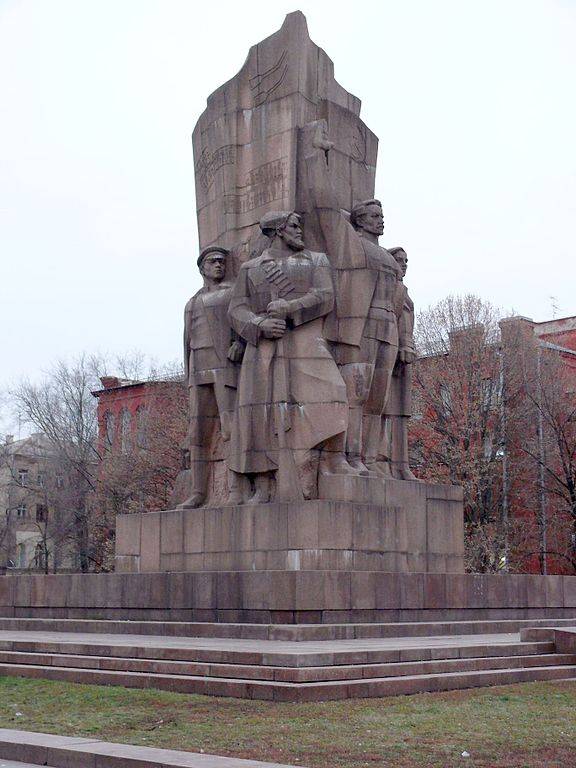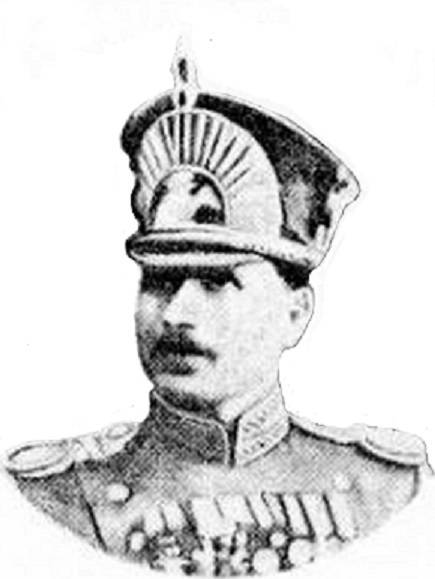How the Bolsheviks liberated Russian Ukraine for the first time

Monument in Kharkov in honor of the proclamation of Soviet power in Ukraine. The monument was founded in 1967, dismantled in 2011.
General situation
In early January 1918, supporters of the Soviet Ukraine, of which Kharkov became the capital, began to form their armed forces, including the so-called. "Red Cossacks", launched an attack on Kyiv (How the Central Rada became the instigator of the Civil War in Russia).
In response, on January 11, 1918, the Rada issued its Fourth Universal - this was the declaration of independence of the Ukrainian People's Republic (UNR). Kyiv immediately received the diplomatic support of Austria-Hungary and Germany. On January 12, the head of the Austrian delegation in Brest, Foreign Minister Count Ottokar Chernin, announced the recognition of the Ukrainian delegation by the Austro-German bloc as a plenipotentiary representative of the sovereign UNR. The Quadruple Alliance needed the resources of Little Russia to continue the war and simply survive. Vienna and other major cities in Austria were already starving. And in winter they froze without coal. The lack of fuel also affected the potential of the military industry. True, Berlin and Vienna thought about their own interests, not the Rada. Kyiv did not receive material assistance from the Germans.
At the end of December 1917, Kharkov and Chernigov were already under the control of the Red Guard detachments. Everywhere, except Yekaterinoslav (later Dnepropetrovsk, now the Dnieper), Soviet power was established peacefully. In Ekaterinoslav, the future "whites" resisted the Reds - detachments of Russian officers, students, high school students, etc. The Rada sent its guards to Poltava - the Bogdanovsky regiment, but the Bogdanovites did not want to fight, but engaged in pogroms and robberies, returned to Kyiv with a lot of booty . Under the control of the Central Rada remained Kyiv, part of the Right Bank, partly Chernihiv, Poltava, Yekaterinoslav and Kherson provinces, where there were separate, scattered detachments of supporters of "independence".
"Red Napoleon"
In early January, the Council of People's Commissars of the RSFSR and the People's Secretariat of the Ukrainian People's Republic of Soviets (UNRS) decided on a joint armed offensive against the troops of the UNR. The main blow was planned through Poltava to Kyiv. The troops were led by Chief of Staff of the Southern Front Mikhail Muravyov. The former tsarist officer, who went uphill after the February Revolution, was actively working to create volunteer shock battalions. After the defeat of the rebellion, Kornila broke off relations with Kerensky and went over to the Left SRs. After the October Revolution, he joined the Bolsheviks.
Muravyov was distinguished by courage and adventurism. Antonov-Ovseenko, who worked closely with him in Little Russia (commander of the Southern Front), called Muravyov "a bold adventurer and an extremely weak politician," who expressed himself in "high calm" and "always lived in a daze." Muravyov indulged the soldier, its worst manifestations. He allowed soldiers to plunder and sack occupied villages and cities.
Tukhachevsky, whom Muravyov almost shot, gave him a capacious description:

M. A. Muravyov in full dress uniform of an officer of the Military Educational Department, with awards (1914)
To Kiev
From Kharkov to Poltava, a detachment of Red Guards and Red Cossacks led the offensive under the command of Vitaly Primakov (the organizer of the Red Cossacks). A detachment of Petrograd and Moscow Red Guards under the command of Pavel Yegorov, an armored train and Red Guards from Yasinovataya under the command of Dmitry Zhloba were coming from the Lozovaya station. The offensive in the main direction was also supported by a special detachment from Moscow under the command of Znamensky, who advanced from Vorozhba station. An auxiliary blow towards the city of Sumy was delivered by the Kharkov detachment of the Red Guard, led by Nikolai Rudnev.
The main offensive was carried out along the Kharkiv-Poltava-Kyiv railway line. The troops during this period of the Civil War worked within the framework of the tactics of "echelon warfare", when small detachments operated along the railways, occupying the most important cities and stations. The entire "army" of Muravyov consisted of about 8 thousand bayonets and sabers. Numerically, the red detachments were small, but in every city and county there were many of their supporters.
Also, the situation was used by criminal elements, bandits who wanted to take a walk, rob and "feel" the bourgeoisie. Such fathers, chieftains have bred throughout the Russian Ukraine since the autumn of 1917, when the incapacity of the Provisional Government became obvious to everyone. The atamans claimed to be fighting for the rights of the "oppressed villagers" and often shared their booty with the locals. And most of the villagers supported gangs, joined the ranks of "self-defense", various gangs, participated in robberies and pogroms of the "city", hid the stolen property.
On January 5 (18), 1918, a battle began on the outskirts of Poltava. The Poltava garrison was not ready for it. On the eve of his main forces were withdrawn to Kyiv to suppress the workers' uprising. Mostly resisted officers and cadets, who had nothing to do with the idea of Ukrainian "independence". On January 6 (19), the Reds occupied Poltava without any problems. Muravyov ordered the prisoners to be shot.
Hundreds of Primakov developed an offensive against Kyiv. Also, the Reds occupied the territory of the Chernihiv, Sumy and Poltava regions without any problems. Skirmishes with Ukrainian troops were sluggish and fleeting, the Haidamaks usually simply scattered at the appearance of the Reds and the slightest pressure. Nobody wanted to die for the "independent Nenko Ukraine". Ukrainian nationalism was still the property of a small part of the intelligentsia. And the Ukrainians themselves did not want to die for “independence”, chatting and shouting from the podium (and even for a good ration, awards and other cookies) is one thing, but going to the bayonet is quite another. The common people took for granted life in a single Russian state, did not divide themselves into Russians and "Ukrainians". And the very name of the state "Ukraine" only sounded.
Protect the central council? So she was also one of the Februaryist revolutionaries. The Bolsheviks promised more blessings. Yes, and the army of Sich Riflemen consisted of the same decomposed soldiers of the former imperial army. They wanted to receive supplies, go for walks, enrich themselves if possible. The Red detachments were usually more united, ideological, although there were enough different rabble.
Odessa Soviet Republic
At the same time, the Reds took over in Odessa. Since the end of 1917, clashes between supporters and opponents of Soviet power have taken place in the city. It came to skirmishes between the Red Guards and the Haidamaks. On January 10, 1918, the commissar of the Odessa Military District, Lieutenant Colonel Poplavko, tried to disarm the pro-Soviet units. It failed to do so.
On the night of January 13-14 (26-27) in Odessa, the uprising of Rumcherod (Council of Soldiers' Deputies from the Romanian Front, Black Sea fleet and Odessa), which stood on Soviet positions. Supporters of Kyiv were about 2 thousand people, Reds - 3,5 thousand people. A detachment on destroyers advanced from Sevastopol to help the uprising.
By the morning of January 14, the rebels occupied the headquarters of the Odessa military district, the station, the telephone exchange, the post office and the telegraph. However, on January 15, Ukrainian units and cadets launched a counterattack, recaptured the station, where reinforcements began to arrive. The Gaidamaks and the Junkers pressed the Reds. However, on January 16, the rebels were supported by fire from the ships of the Black Sea Fleet - the battleships Sinop, Rostislav and the cruiser Almaz. From the side of the Odessa-Tovarnaya station, the Zaamurets self-propelled armored car advanced on the Ukrainian units. The main armament of the motorized armored car consisted of two coastal guns designed by Nordenfeld, caliber 57 mm, which had a high rate of fire - 60 rounds per minute. The armored car was also armed with 12 Maxim machine guns.
By January 17 (30), the Reds recaptured the previously lost positions, captured the Odessa Military School. The Gaidamaks capitulated. On the evening of January 18, the Central Executive Committee of Rumcherod elected the Council of People's Commissars of the Odessa Soviet Republic (OSR), which recognized the supreme power in the person of the Petrograd SNK and the Soviet government in Kharkov. Vladimir Yudovsky was elected Chairman of the Council of People's Commissars of the OSR (SNKOR). The leadership of the OSR stated that it was subordinate only to Petrograd, and the republic (Odessa and Bessarabia provinces) was not part of Ukraine, since it had a mostly non-Ukrainian population.
On January 21, the funeral of the victims of the three-day battle in Odessa took place. All were buried in a mass grave on the Kulikovo field. During the fighting, 119 people died, 359 were wounded.
Muravyov, who led the armed forces of the OSR, began terror. In particular, the Naval Tribunal was organized on the Almaz cruiser, where officers were executed. The unfortunate were thrown into furnaces, doused with water on the deck, turning people into blocks of ice that were dumped into the sea.
To be continued ...
Information